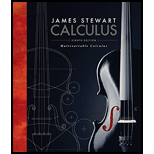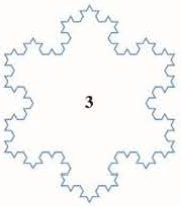
To construct the snowflake curve, start with an equilateral triangle with sides of length 1. Step 1 in the construction is to divide each side into three equal parts, construct an equilateral triangle on the middle part, and then delete the middle part (see the figure). Step 2 is to repeat step 1 for each side of the resulting
- (a) Let sn, ln, and pn represent the number of sides, the length of a side, and the total length of the nth approximating curve (the curve obtained alter step n of the construction), respectively. Find formulas for sn, ln, and pn.
- (b) Show that pn → ∞ as n → ∞.
- (c) Sum an infinite series to find the area enclosed by the snowflake curve.
Note: Parts (b) and (c) show that the snowflake curve is infinitely long but encloses only a finite area.
FIGURE FOR PROBLEM 5


Trending nowThis is a popular solution!

Chapter 11 Solutions
Multivariable Calculus
Additional Math Textbook Solutions
Calculus Early Transcendentals, Binder Ready Version
Thomas' Calculus: Early Transcendentals (14th Edition)
Precalculus (6th Edition)
Precalculus
Calculus For The Life Sciences
Calculus & Its Applications (14th Edition)
- Laying Phone Cable City A lies on the north bank of a river that is 1 mile wide. You need to run a phone cable from City A to City B, which lies on the opposite bank 5 miles down the river. You will lay L miles of the cable along the north shore of the river, and from the end of that stretch of cable you will lay W miles of cable running under water directly toward City B. See Figure 2.108. Figure 2.108 You will need the following fact about right triangles: A right triangle has two legs, which meet at the right angle, and the hypotenuse, which is the longest side. An ancient and beautiful formula, the Pythagorean theorem, relates the lengths of the three sides: Lengthofhypotenuse=Lengthofoneleg2+Lengthofotherleg2 a. Find an appropriate right triangle that shows that W=1+(5L)2 b. Find a formula for the length of the total phone cable P from City A to City B as a function of L. c. Make a graph of the total phone cable length P as a function of L, and explain what the graph is showing. d. What value of L gives the least length for the total phone cable? Draw a picture showing the least-length total phone cable.arrow_forwardUse Figure 5.19 to prove Theorem 5.4.2. Theorem 5.4.2 The length of the altitude to the hypotenuse of a right triangle is the geometric mean of the lengths of the segments of the hypotenuse.arrow_forwardA calendar is determined by using each of the 12 faces of a regular dodecahedron for one month of the year. With each side of the regular pentagonal face measuring 4cm, the area of each face is approximately 27.5 cm2. a What is the total surface area of the calendar? b If the material used to construct the calendar costs 0.8 of a cent per square centimeter, what is the cost of the materials used in construction?arrow_forward
- Refer to the shaft shown in Figure 6-4. Determine the missing dimensions in the table using the dimensions given. All dimensions are in inches.arrow_forwardIf line segment AB and line segment CD in the accompanying drawing are drawn to scale, what does intuition tell you about the length of these segments?arrow_forward
 Functions and Change: A Modeling Approach to Coll...AlgebraISBN:9781337111348Author:Bruce Crauder, Benny Evans, Alan NoellPublisher:Cengage Learning
Functions and Change: A Modeling Approach to Coll...AlgebraISBN:9781337111348Author:Bruce Crauder, Benny Evans, Alan NoellPublisher:Cengage Learning Mathematics For Machine TechnologyAdvanced MathISBN:9781337798310Author:Peterson, John.Publisher:Cengage Learning,
Mathematics For Machine TechnologyAdvanced MathISBN:9781337798310Author:Peterson, John.Publisher:Cengage Learning, Elementary Geometry For College Students, 7eGeometryISBN:9781337614085Author:Alexander, Daniel C.; Koeberlein, Geralyn M.Publisher:Cengage,
Elementary Geometry For College Students, 7eGeometryISBN:9781337614085Author:Alexander, Daniel C.; Koeberlein, Geralyn M.Publisher:Cengage,


